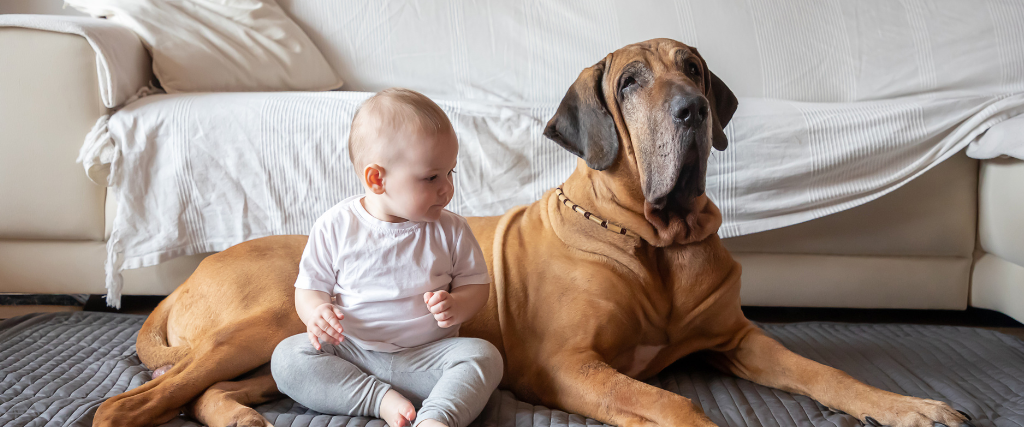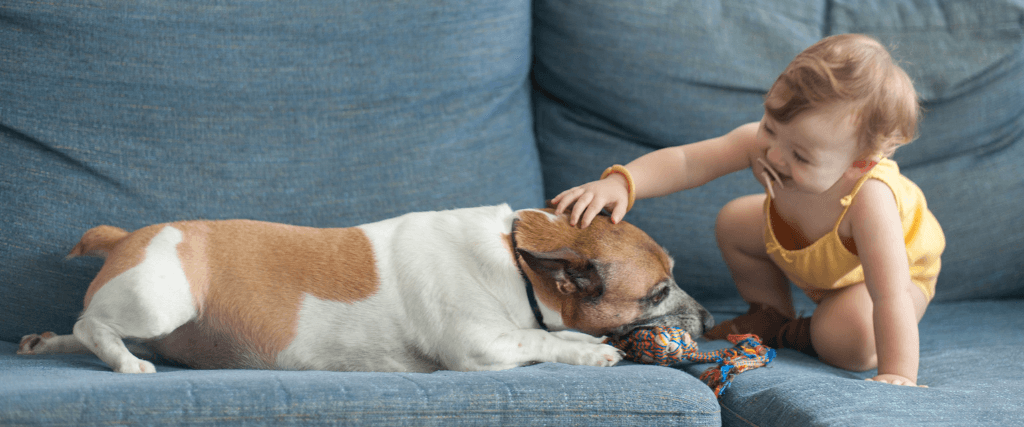This post was written by our friend Melissa R. Shyan Norwalt, Ph.D., CAAB
Bringing home a new baby? Adopting? Having people come over for the Holidays? Training your dog to accept a baby is helpful and a very good idea. It makes the dog safer and makes the baby safer. It's important to think of this as not only protecting your baby from your dog, but also as protecting your dog from the baby. A dog that is seen as aggressive or too rough with a baby even during short term visits usually ends up being rehomed, relinquished to a shelter, or euthanized. . This is pretty miserable for the dog, and the owners. Please know that each case is very individual and I cannot map out a full baby-training program in a blog. Such protocols can help, but they need to be individualized to your specific situation. So let's talk about what how, why, and when (but not in that order).
WHEN: Start months before bringing a baby home. Please don't wait until the last minute. Finding out how your dog is likely to act around babies, crawlers, toddlers, and preschoolers is very important but you have to have this information early so you know what to do. Waiting baby will be around your pet gives you little time, and gives the dog no time, to learn what's expected.

I recently received a call from a family who was adopting a baby. They had a 3 year old lab mix who was good with children, but was "exuberant" and "excitable" in nature. They wanted to know how to introduce the baby to the dog. When did they call? Four hours before the baby was coming home! We made it work (dog gates are our friends), but that is just too short a time to get a dog used to the idea of a baby in the house. Now, granted, adopting parents-to-be can't predict when a baby will become available for adoption. But adoptive parents know they are planning on adopting, and baby training can take from one to three months long. Be proactive; don't wait until the baby is coming home. Starting three months early is a good estimate of time to help your dog be successful.
I had a case where the owners called me because they had a standard poodle who was a fear biter. She was a "sneaky" biter: would retreat if faced, but pinch your bottom when you turned away. We no sooner got this under control, than the owner called me to say she was pregnant and was worried about how this reactive dog would handle a baby in the house. We set up a baby-training protocol for the last six months of her pregnancy. The dog did great! Then, a year later, the owner called to say that the baby was crawling and the dog was "mothering" the baby by blocking her way, licking her face, and refusing to let her crawl anywhere! What a great problem to have. So we started having the baby "train" the dog on obedience commands. The baby sat on Mom's lap, Mom gave a command, and the baby (with help from Mom) rewarded the dog with treats. The dog transitioned from seeing the baby as something to mother, to something she had to listen to, a human. Proactive is so much easier and effective than last minute.
WHY: You want to have time to discover how the dog is likely to act, desensitize the dog to the sights, sounds, and smells of a baby, encourage the dog to be calm and relaxed around the baby, and train the dog to see the baby as a human, not a puppy or a toy.
1. How is the dog likely to act:
- Has your dog met babies before? How did it behave? Was it calm? Curious? Barky? Puppy Nippy (tried to pinch and pull the baby's clothing to play)? Snappy (snapped near the baby in a non-play, defensive or aggressive manner? (Can't tell the difference? Contact a behaviorist for help!)
- Has your dog met toddlers before? How did it behave? Try to play (showed a play bow and bouncy behavior)? Showed growling, snarling, or tail tucked behavior? Ran away from the crawler?
2. Don't have access to babies and toddlers for 1) above? Use models:
- When I am evaluating a dog with babies, I bring a baby doll that looks like a newborn. It cries, coos, and laughs when I press its tummy. I hold it like a baby, treat it like a baby, and have it make sounds. I present it to the dog while holding the doll in my arms, in my lap, and then by laying the doll on the floor.
- NOTE: The dog DOESN'T think this is a baby. It smells like plastic, for one thing. Some dogs think it is a play-toy and will try to use it for a game of fetch. Research shows that dogs who are excessively reactive to novel-objects are likely to be snappy towards children. So the baby doll isn't seen as a "living baby" but it serves as a model for reactivity. The dogs who treat it like a toy don't bother me--we can work with that. The dogs who get snappy, growly, bark excessively, retreat and approach defensively, really need help. For dogs like this you want a professional to help you.
- Toddler Dolls: These are harder to find. I have two: one is an old "Play With Me Barbie Doll"--the 3' kind that they used to sell. The other is a doll that looks like a 3 year old toddler that I found at a flea market.
- Again, these life-sized dolls don't smell like humans. But we are looking for that "reactivity" level. I hold the doll by the neck and "walk" it towards the dog. I put a treat in the doll's hand and have it "feed" the dog. I extend one of the doll's arms and have it try to "pet" the dog. Again, research shows that dogs who are excessively reactive to novel-objects are likely to be snappy towards children. So the toddler doll isn't seen as a "living child" but it serves as a model for reactivity. If your dog is reactive--ask a professional for help.

3. HOW: Each dog and family is different and there just isn't a "one size fits all" program, but here are some general ideas.
- Dog Gates, Dog Gates, Dog Gates (or Child Gates)!: The ASPCA reports that children under 12 years of age should never be left alone with a dog. If you cannot supervise your dog with your new baby, or with your children, separate them! Don't let yourself become overwhelmed or distracted when life throws one of those curve balls. The baby is crying, the phone is ringing, someone is ringing the doorbell, the dinner is burning, and the dog is barking. First thing FIRST THING--put the dog someplace where he is physically separated from the baby with a barrier in between. THEN pull the dinner off the stove, pick up the baby, answer the door, and let the answering machine answer the phone (in that order).
- Desensitize to Baby Routines: Practice feeding a baby doll, changing a baby doll, playing with a baby doll. Use a doll that makes noise and get the dog used to the sounds. Bring baby odors, baby sounds, baby activities, friends' babies into the house and let the dog get used to them. Use barriers (Gates, leashes, et cet) as necessary for safety. Offer treats when babies are present. If your dog is a calm relaxed dog, let the dog sniff the baby. Manipulate the baby's hand and have the baby "offer treats" to the dog, if the dog is a gentle treat taker. If the dog is a mouthy treat taker, have the dog be held by someone and help the friend's baby "toss" the treats to the dog. Safety First--keep things calm and under control. Start at distances where the dog can stay calm, and then move closer. Use short periods of time (3-5 mins or less) with lots of separation breaks, as needed.
- Safety-Zone: Dogs can be trained to self-regulate and self-monitor their own behavior. If a dog starts to feel anxious, it can learn to "go to my safe place." The dog's own emotional state can act as a cue (just like "Sit" is a cue) to retreat to the designated "Safety Zone." That way if the baby is fussy and the dog becomes anxious, it will take itself to it's safety zone. Give it a long-term chewy treat for doing so. This training takes time (start early--before there's a need for it), and I can't really present all the steps here.
The most critical thing is to be proactive. Start early, practice often. If you feel your pet and you need some extra help always contact a professional for assistance. Your pet will thank you!

